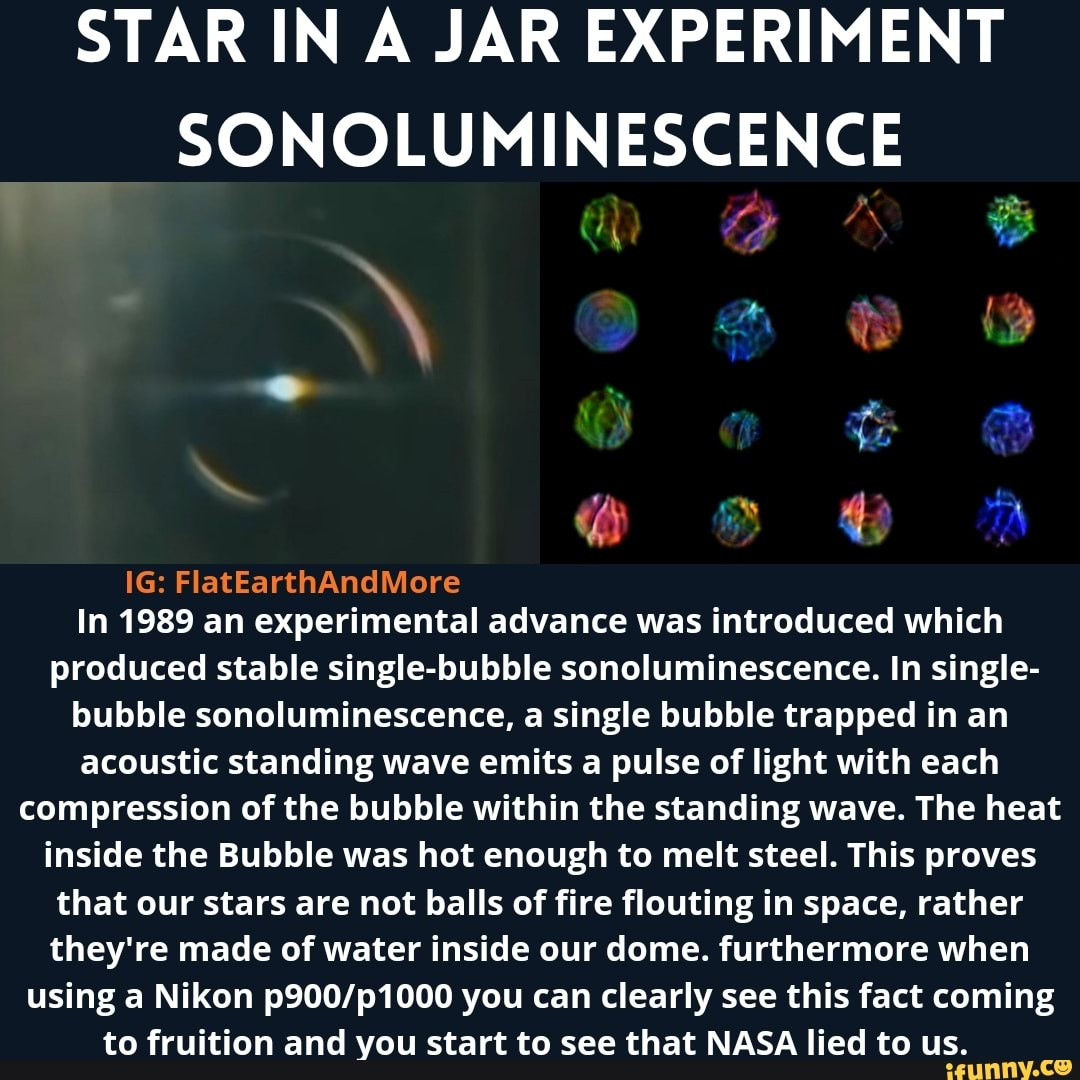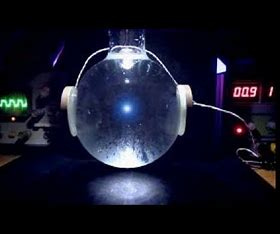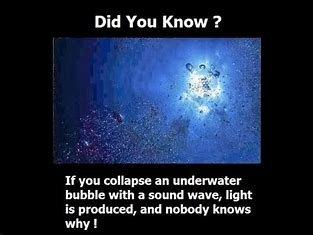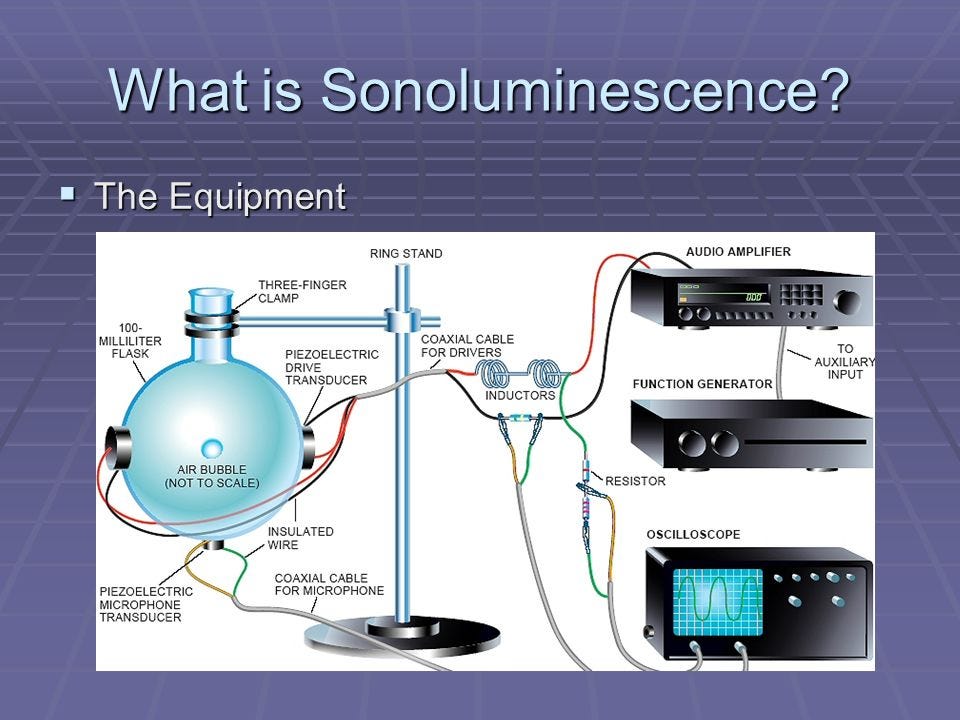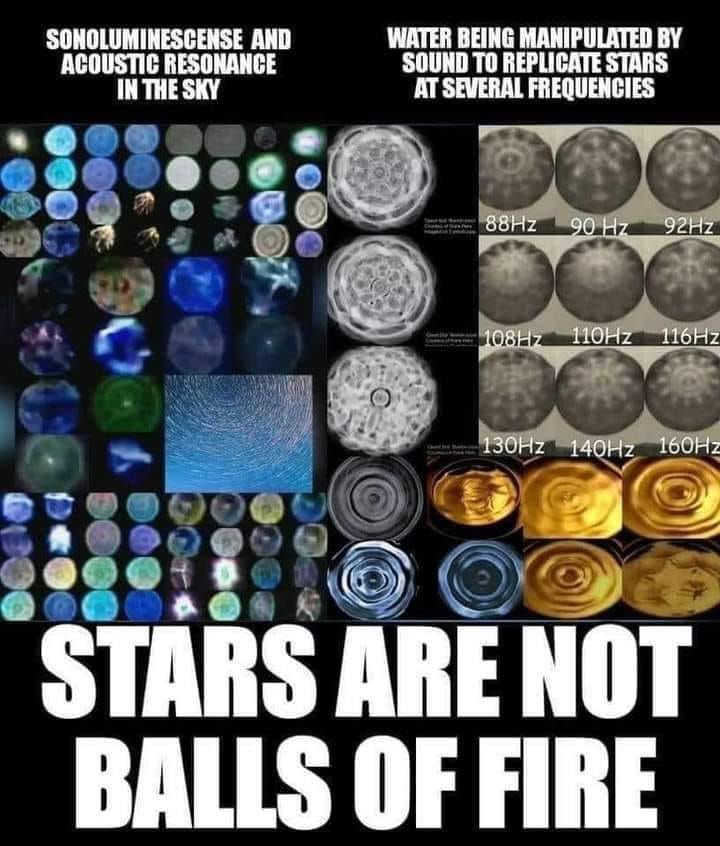Sonoluminescence – A Star in a Jar: Stars are Not Massive Nuclear Fusion Sun Infernos
Sonoluminescence and The Stars
Every Star has an acoustical musical resonance, given at a value commensurate to a pressurized system, which subsequently, holds matter into a pressurized density within a watery medium. This acoustical musical resonance effect, known as Sonoluminescence, is how Stars are maintained in existence within the watery Firmament above.
Sonoluminescence is the emission of light during acoustic cavitation, the process of bubble growth and rapid collapse in a liquid under the influence of ultrasound. Acoustic cavitation is the formation, growth, and violent collapse of microbubbles in a liquid under the influence of an ultrasonic field or pressure changes. This phenomenon generates extreme local temperatures and pressures, which can be harnessed for applications like chemical reactions and energy capture.
With Sonoluminescence, the sound waves cause gaseous bubbles to form and then violently implode, creating temporary hot spots within the liquid that generate light flashes. These conditions can reach temperatures of up to 20,000 K and pressures of several thousand bar, forming a plasma-like state inside the collapsing bubble.
The Lord Spoke The World Into Existence:
The Sound by which all things are created isn’t just any sound. It’s The Word of God. In the Bible John wrote, “In the beginning was the Word, and The Word was with God, and The Word was God.” Through Sonoluminescence, The Lord animates all The Stars and heavenly bodies. The Stars are the result of the sound of God. The Lord spoke The World into existence, and with “The Word”, was vibration and frequency. All of existence, including matter and light, is animated and sustained by vibration and frequency, including The Luminaries above The Earth. The concept of God speaking the world into existence is a central theme in biblical creation stories, particularly in The Book of Genesis. It signifies that God’s Word has the power to create and bring things into being. This idea is often expressed through the phrase “Let there be Light”, and what is Sonoluminescence but light created by vibratory sound.
Experiment:
1. Professor Seth Putterman at UCLA creates The Sonoluminescent Effect
2. Temperature of Star = 22,000 Kelvin which is 21726.85 degrees.
Sonoluminescence - Star in a Jar:
The speculation that inside the star it burns at over 10,000,000 degrees, which is the estimated temperature of the core of The Sun in The Heliocentric Model, in a fusion process is something I cannot verify. Nevertheless, the exterior is over 21726.85 degrees and yet the star remains tiny in its picosecond expansion and contraction cycles, with tens of thousands of oscillations per second, according to MIT. Nobody understands it fully. As long as the sound is tuned on, the star remains twinkling, burning at the exterior at 21726.85 degrees, while the surrounding fluid in the container does not heat up. This baffles MIT scientists.
Sonoluminescence in Modern Cinema
The 1996 Movie, Chain Reaction, Exbibits Sonoluminescent Power Via a Hydrogen Gas Bubble in an Enclosed Jar of Water:
Chain Reaction is a 1996 American science fiction action thriller film directed by Andrew Davis and starring Keanu Reeves, Morgan Freeman, Rachel Weisz, Fred Ward, Kevin Dunn and Brian Cox. The plot centers on the invention of a new non-contaminating power source based on hydrogen and the attempts by the United States Government to prevent the spreading of this technology to other countries. The film was released in the United States on August 2, 1996.
While working with a team from the University of Chicago on a project to convert hydrogen from water into clean energy, student machinist Eddie Kasalivich inadvertently discovers a sound frequency in his home laboratory that perfectly stabilizes their process the next day. The movie overtly states that they were working on Sonoluminescence as an energy source.
An example of Sonoluminescence from the movie, Chain Reaction, where an ultrasound frequency activates a bubble of hydrogen to create energy:
Eddie Solves the Machine ~ Chain Reaction (1996):
Hence, the Luminaries in the Firmament Above are Examples of Sonoluminescence.
Thunderbolts – Turning Sound Into Light
by Jimmy Mikecz
What if sound didn’t only flow through matter but could produce unexpected phenomena like light? Research in sound has revealed the capacity of sound to influence matter in a way that produces light. The phenomenon of Sonoluminescence (SL) is one example of this relationship.
“If you want to find the secrets of the universe, think in terms of energy, frequency, and vibration.”—Nikola Tesla
Sonoluminescence occurs when high-frequency sound vibrates tiny gas bubbles to reach star-like temperatures and emit flashes of light. The mechanism of sonoluminescence is not fully understood but its occurrence is well documented. As SL researchers probe deeper into the phenomenon, they have found that current fluid dynamic equations cannot explain why it happens. SL is a natural phenomenon as well, and marine biologists observe some species of shrimp using it as an attack against other creatures. It is the bridge between sound and light and can offer a deeper understanding of nature’s laws.
Sonoluminescence
In a study at UCLA called Sonoluminescence: How Bubbles Turn Sound into Light, scientists S.J. Putterman and K.R. Weninger explore the mathematics and phenomenology of sonoluminescence. It is known that this phenomenon is caused by the rapid expansion and contraction of a bubble. This is known because the broad-band UV light emitted appears at a frequency, though not continuously. Think of a strobe light as an analogy where flashes of light last only pico-seconds (trillionths of a second.) According to Prof. Putterman, the phenomenon of sonoluminescence can heat bubbles up to tens of thousands of degrees. The surface of these bubbles burns at about 20,000 K (~35,000 °F) and look like “little stars.”
“Sonoluminescence, the transduction of sound into light, is a phenomenon that pushes fluid mechanics beyond its limit.”
—Drs. S. J. Putterman and K. R. Weninger, UCLA Physics Department
Sonoluminescence can be repeatedly produced in a controlled laboratory environment. Some of the key requirements are degassed water, a noble-gas mixture bubble, and a source of a high-frequency sound. Typically the sound is produced by a piezo-electric element. The scale of the experiment is typically small. Only about a cup-full of water is necessary, and the size of the bubble is typically only microns in size.
Sonoluminescence is in action below. It should be obvious why the phenomenon has gotten the nickname of “star in a jar.” The small cavitating bubble takes on the appearance of a small star.
Sonoluminescence. In the center of the glass, a small blueish glowing bubble is visible. The frequency is about 25.7 kHz. The solution inside the glassware is partially degassed demi-water below room temperature. The glassware is handblown for an optimal spherical shape. This photo is taken in a darkened room with a camera exposure time of four seconds. Piezoelectric elements are glued to the glass with epoxy glue and the laboratory stand clamp has a cork lining inside.
Fluid Dynamics
Conventional fluid dynamic equations do not account for sonoluminescence entirely. Specifically, some researchers have applied Rayleigh’s equations to the bubble collapse but this “violates it’s domain of applicability” according to Putterman and Weninger. This violation occurs because Rayleigh’s equation is only for low Mach number motion, and the bubble collapse occurs at high Mach number. Putterman and Weninger also suggest that researchers misapply Saha’s equation and Bremsstrahlung equations to this phenomena. Without getting too deep into the details of these equations, Saha’s equation typically describes an ionization state of a gas relative to its temperature and pressure. Similarly, Bremsstrahlung equations typically describe electromagnetic radiation produced by the deceleration of a charged particle. At present, these equations do not adequately explain sonoluminescence for a variety of reasons.
Plasma Core?
Plasma is the fourth state of matter, commonly generated during lightning strikes. Research shows the inner core of sonoluminescent bubbles could be plasma.
Some researchers believe that during sonoluminescence, bubbles have an inner core of plasma. In a study published in peer-reviewed Journal Nature, entitled “Plasma formation and temperature measurement during single-bubble cavitation,” researchers state that “emitting species must originate from collisions with high-energy electrons, ions, or particles from a hot plasma core.” Other research supports the hypothesis that SL bubbles have a hot plasma core.
According to another recent publication called “Evidence for a Plasma Core during Multibubble Sonoluminescence in Sulfuric Acid”: “. . . the observation of molecular and atomic ions is the first experimental demonstration of an inner ionized plasma core during single-bubble cavitation.” Thus, current research suggests that the core of the SL bubbles may be plasma, the fourth fundamental state of matter. Perhaps this is the reason why fluid dynamic equations do not match the phenomenon.
Other Known Qualities of Sonoluminescent Bubbles
Researchers discovered that during sonoluminescence, a bubble rapidly expands then contracts in cavitation. Looking deeper into this, researchers have found that the bubble does operate within some conventional chemical laws. One of these is the fact that, as the bubble collapses, it rebounds because of Van Der Waals forces.
The accompanying graph depicts the collapse of a cavitating bubble over time. Notice that the bubble has a peak radius of about 5.3 micrometers. The bubble then rapidly collapses in about 20 nanoseconds. As the bubble “bottoms out” (approaches the van der Waals radius, rw ), it springs back and oscillates through several cycles of expansion and contraction.
Noble Gases
Sonoluminescence appears to emit the most light with noble gases or noble gas mixtures. This is probably because of the inherent non-reactivity of the noble gas chemical group. Researchers use helium, neon, argon, and xenon to create SL. Star-in-a-jar researchers use oxygen and nitrogen mixed with a noble gas to create sonoluminescence in a laboratory. According to Putterman and Weninger, SL with only oxygen and nitrogen is difficult. A nitrogen and oxygen mixture produces a “dim light.” The article also states that noble gases concentrate in the bubble as cavitation occurs. This happens because the force of the bubble collapse causes reactive elements (H2O, N2, O2) to dissociate. Then, the surrounding water draws these gases into it.
Image of Sonoluminescence. Source: Putterman, Weninger
Shrimpoluminescence
An incredible example of sonoluminescence is the “stun” action of both the pistol and mantis shrimp. These predatory shrimp knock-out their prey by “loading” their claws with tension and releasing it suddenly. The shrimp clamps its claws shut at such an extreme velocity that the surrounding water vaporizes. As in the laboratory form of SL, this extreme cavitation produces the same light and extreme surface temperatures [3]. However, this light is not visible to the naked eye as in the laboratory experiment. The video below depicts this amazing process. Researchers Detlef Lohse, Barbara Schmitz, and Michel Versluis have named this “shrimpoluminescence.” An article published in Nature regarding the topic called “Snapping Shrimp Make Flashing Bubbles” states plainly that SL occurs at the snap.
A Bridge Between Sound and Light
It is not obvious why a bubble created by high-frequency sound contained in nothing more than a glass of water could reach temperatures close to the surface of the sun. Not surprisingly, researchers first looked at fluid dynamics to reach an explanation for sonoluminescence but found it lacking. Could plasma physics be the road by which an explanation will arrive? Would the Electric Universe model explain what is happening? As more research unfolds, a deeper understanding of the nature of this bridge between sound and light could lead both to greater scientific understanding and practical applications.
Real Stars Are Not Planets
Frequency of The Heavens: Cymatics, Bio and Sonoluminescence, Actual Stars, and “Planets”:
Wandering Star Venus, the Sun and Sea Observation - Nikon P900:
The Lights in the Firmament Above: Sonoluminescence:
Stars and the “Planets”, aka Wandering Stars, are not what we’ve been told they are. They are Sonoluminescent phenomena. All of Creation is immersed Electromagnetic Energy Fields, and not Atomistic Particles. These Divine Energies are more connected to us then we’ve been lead to believe, but since the Heliocentric Cosmology Lie was forced upon us, we’ve since been disconnected to them. We live in a divine world where we have been led to beLIEve we are nothing but specks of dust on a spinning ball in an vast Outer Space vacuum. Nothing could be farther from The Truth.
The Lights in the FIRMAMENT Above:
Sonoluminescence - Star in a Jar:
STARS Through a Telescope: Arcturus, Procyon, Astronomy: HOW STARS REALLY LOOK:
Venus Nonsense You Tube Video: Sonoluminescence - Star in a Jar:
Punching Water So Hard LIGHT Comes Out – Sonoluminescence:
VIDEO PROOF The Moon, Stars + Planet X Are MUCH CLOSER Than You Were Told!! | Fe PROOF 15 pt1:
PROOF Stars ARE NOT What You Were Told!! + They ARE NOT Trillions Of Miles Away!! | FE PROOF 15 pt2:
Stars ARE NOT Distant Suns!! They ACTUALLY!! | THINK QUICK ep23
Scientist CREATE Star In Water Using Sound Waves!! PROOF of Waters Above? | FE ADVANCED ep24:


